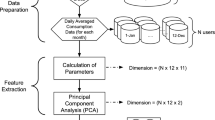Abstract
Source separation of whole-home electrical consumption also known as energy disaggregation plays a crucial role in energy savings and sustainable development. One important approach towards accurate energy disaggregation is based on sparse code learning. The sparsity-based source separation algorithms allow to build models that explicitly generalize across multiple different devices of the same category. While this method has recently been investigated, yet the importance of the degree of sparseness given by the regularization parameter is rarely considered. In this paper we aim at investigating the performance of learning representations from the aggregated electrical load signal with sparse models for energy disaggregation. In particular we focus our study on the influence of the regularization parameter in the overall approach. The computational experiments yielded in real data from home electrical energy consumption show that for several degrees of sparseness a reliable scheme for energy disaggregation can be obtained with statistical significance.
Access this chapter
Tax calculation will be finalised at checkout
Purchases are for personal use only
Preview
Unable to display preview. Download preview PDF.
Similar content being viewed by others
References
Hart, G.W.: Nonintrusive appliance load monitoring. Proc. of the IEEE 80, 1870–1891 (1992)
Sultanem, F.: Using appliance signatures for monitoring residential loads at meter panel level. IEEE Transactions on Power Delivery 6, 1380–1385 (1991)
Zico Kolter, J., Batra, S., Ng, A.: Energy disaggregation via discriminative sparse coding. In: Lafferty, J., Williams, C.K.I., Shawe-Taylor, J., Zemel, R., Culotta, A. (eds.) Advances in Neural Information Processing Systems, vol. 23, pp. 1153–1161 (2010)
Cole, A., Albicki, A.: Algorithm for non intrusive identification of residential appliances. In: Proc. of the IEEE Intl. Symposium on Circuits and Systems, vol. 3, pp. 338–341 (1998)
Patel, S.N., Robertson, T., Kientz, J.A., Reynolds, M.S., Abowd, G.D.: At the Flick of a Switch: Detecting and Classifying Unique Electrical Events on the Residential Power Line (Nominated for the Best Paper Award). In: Krumm, J., Abowd, G.D., Seneviratne, A., Strang, T. (eds.) UbiComp 2007. LNCS, vol. 4717, pp. 271–288. Springer, Heidelberg (2007)
Figueiredo, M., De Almeida, A., Ribeiro, B.: Home electrical signal disaggregation for non-intrusive load monitoring (NILM) systems. Neurocomputing 96, 66–73 (2012)
Hoyer, P.O.: Non-negative sparse coding. In: Proc. IEEE Workshop on Neural Networks for Signal Processing, pp. 557–565 (2002)
Eggert, J., Korner, E.: Sparse coding and nmf. In: Proc. IEEE Intl. Joint Conf. on Neural Networks, vol. 4, pp. 2529–2533 (2004)
Friedman, J., Hastie, T., Höfling, H., Tibshirani, R.: Pathwise coordinate optimization. The Annals of Applied Statistics 1(2), 302–332 (2007)
Friedman, J., Hastie, T., Tibshirani, R.: A note on the group lasso and a sparse group lasso. Technical report, Stanford University (2010)
Kolter, J.Z., Johnson, M.J.: REDD: A Public Data Set for Energy Disaggregation Research. In: Proc. of SustKDD Workshop on Data Mining Applications in Sustainability (2011)
Author information
Authors and Affiliations
Editor information
Editors and Affiliations
Rights and permissions
Copyright information
© 2013 Springer-Verlag Berlin Heidelberg
About this paper
Cite this paper
Figueiredo, M., Ribeiro, B., de Almeida, A.M. (2013). On the Regularization Parameter Selection for Sparse Code Learning in Electrical Source Separation. In: Tomassini, M., Antonioni, A., Daolio, F., Buesser, P. (eds) Adaptive and Natural Computing Algorithms. ICANNGA 2013. Lecture Notes in Computer Science, vol 7824. Springer, Berlin, Heidelberg. https://doi.org/10.1007/978-3-642-37213-1_29
Download citation
DOI: https://doi.org/10.1007/978-3-642-37213-1_29
Publisher Name: Springer, Berlin, Heidelberg
Print ISBN: 978-3-642-37212-4
Online ISBN: 978-3-642-37213-1
eBook Packages: Computer ScienceComputer Science (R0)




